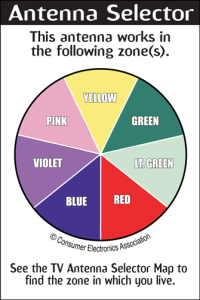Before we dive in, let’s talk tech for a minute…there’s technically no such thing as an HDTV antenna. Antennas are made to receive “over the air” (OTA) signals. It doesn’t matter if the antenna says it’s HDTV compatible or not. What matters is if the signal that is being broadcast is High Definition (HD). The signal is the responsibly of the TV station, not the antenna that is receiving it. An antenna labeled HDTV antenna is about marketing. The moral of this short tech talk is don’t be tricked into paying more for an antenna labeled HDTV.
If you think that’s good news, I’ve got even better news! Picking an outdoor antenna is pretty straightforward. There’s four basic steps…
- Determine your distance and direction from the broadcast towers
- Determine the CEA-certified color code required for your location
- Determine if you need a directional or a Multi/Omni-Directional antenna
- Enjoy free, crystal clear, HDTV!
Step One : Where Are You?
 The first step in choosing an outdoor antenna is deciding where you are in relation to the television broadcast towers. There’s two things to consider 1) Is there anything between you and the broadcast tower that may obstruct the signal? 2) Are you relatively close to the broadcast tower?
The first step in choosing an outdoor antenna is deciding where you are in relation to the television broadcast towers. There’s two things to consider 1) Is there anything between you and the broadcast tower that may obstruct the signal? 2) Are you relatively close to the broadcast tower?
If the view from your window looks like the image to the right, I envy you, but there is a possibility you may have an issue with geographic features limiting your signal. Similar to a person standing in front of the TV blocks your view and causes the remote not to work it’s very possible for a mountain, large enough building, or other obstruction to degrade your OTA signal. Sadly, we can’t just ask a mountain or building to move. Fortunately, you don’t need a clear “line of sight” to get HDTV signals. Also, it’s in the TV stations best interest to provide a signal to as many people as possible so there’s a good chance if you live within a reasonable distance of a broadcast tower you’ll get a signal. That brings us to the next consideration; how far is a reasonable distance from a broadcast tower?
It depends on your local television market, but generally it’s about 70 miles. “Great! but how the heck I’m I supposed to know how far away I am from a broadcast tower?” I’m happy you asked. There are several tools available online that let you input your address and/or zip code and show you the location of the towers and distance from your location. Below are links to a few such sites…
http://www.gomohu.com/TV-FOR-FREE-FRONT
 Step Two : Color Me Impressed
Step Two : Color Me Impressed
One of the big advantages when buying an outdoor antenna is the color coded label system that helps consumers purchase the appropriate antenna. CEA (Consumer Electronics Association) certified outdoor antennas will be labeled with an “Antenna Selector” badge similar to the one below showing which color zone the antenna is designed to work in. Using the web tools in “Part One : Where Are you?” you’ll be able to see which color zone is right for you.
Step Three : One Direction?
You’ve checked for geographic anomalies, you’ve determined your distance from the broadcast towers, and now you know your color codes, but there’s one more thing to consider, direction. Which direction are the towers located? Antenna’s come in two direction flavors…
- Directional (think One Direction)
- if the towers are located in the same direction this is the choice for you.
- can receive signals from a greater distance.
- should be “aimed” towards the tower/s you want to receive signals from.
- Multi/omni directional
- if the towers are more spread out around you you’ll want to choose an omni/multi directional antenna.
- receive signals from a shorter distance than a directional antenna.
- don’t require much, if any, aiming as they pick up signals from a broader swath of area.
Imagine your house is the center of an old analog clock/watch. If all the broadcast towers are by the six on the clock you’ll want a One Direction antenna (which is the Story of My Life). If some of the towers are by the six and others are by the three you’ll want an omni/multi-directional antenna.
“But, I’m really far away and the towers are spread out all over the clock?!” The simplest and most economical solution is to determine which channels you want most and point a One Directional antenna at them. If that just won’t do, there’s motorized products on the market that will actually change the direction of the antenna for you.
Step Four : It’s Beautiful
While a “HDTV antenna” may be a marketing term, once you’ve got your antenna installed and you’re viewing gorgeous HDTV, at a higher resolution than the cable or satellite providers offer, you’ll feel like a genius. I know I did and the process was so much easier than I imagined it would be.
To Recap…
- Where are you? – Determine your location from broadcast towers
- Color me Impressed – Use the web tools to get your color codes
- One Direction? – Determine if you need a directional or omni/multi-directional antenna
- Armed with the information go shop in confidence!
